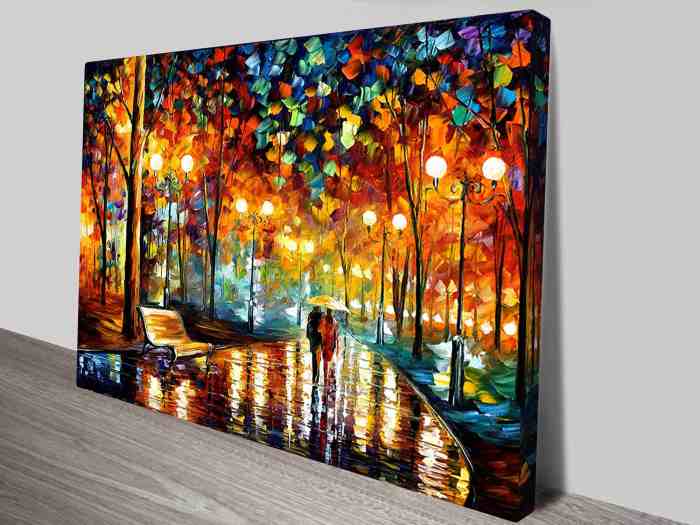Design Elements for Effective Canvas Prints

Contoh desain cetak kanvas – Crea
Right, so you’re into canvas print design, that’s ace. Thinking about the visuals, it’s a bit like designing campaign posters, innit? Check out this link for some ideas on election candidate designs – contoh desain calon prmilihan calaon krtua nem – they’re pretty banging for inspiration, even if it’s a different ball game. You could totally adapt those bold graphics and colour palettes for your canvas prints, making them proper eye-catching.
ting a compelling canvas print involves a nuanced understanding of design principles. The interplay of color, layout, typography, and negative space significantly impacts the overall aesthetic appeal and emotional resonance of the final product. Effective design choices transform a simple photograph or artwork into a captivating visual experience.
Effective Color Palettes for Canvas Prints
Color psychology plays a crucial role in determining the mood and theme of a canvas print. Different color palettes evoke specific emotional responses and can be strategically used to enhance the overall impact of the artwork. For instance, cool palettes, dominated by blues, greens, and purples, often project a sense of calm, serenity, and tranquility. These are well-suited for landscapes depicting tranquil scenes, such as a serene beach at sunset or a misty mountain range.
Conversely, warm palettes, featuring reds, oranges, and yellows, create a feeling of energy, excitement, and warmth. These palettes are ideal for vibrant scenes, such as a bustling city street at night or a field of sunflowers in full bloom. Monochromatic palettes, using variations of a single color, offer a sense of elegance and sophistication, often used for minimalist designs or portraits.
Finally, analogous palettes, employing colors adjacent to each other on the color wheel, create a harmonious and balanced look.
Sample Landscape Canvas Print Layout
Consider a landscape photograph featuring a majestic mountain range at dawn. The layout could be designed to emphasize the grandeur of the mountains. The mountains themselves would occupy the majority of the canvas, extending from the lower third to the upper two-thirds. The lower third could feature a tranquil lake reflecting the morning light, creating a sense of depth and tranquility.
The sky, a gradient of soft pinks and oranges, would occupy the upper portion, providing a sense of vastness. This asymmetrical composition creates visual interest and draws the viewer’s eye across the canvas. The overall effect aims to capture the serenity and magnificence of the natural scene.
Text Font Selection for Canvas Prints
Choosing the right font is crucial for readability and aesthetic appeal in canvas prints, especially when incorporating text. The font’s style, weight, and size should complement the overall design and ensure easy readability from a distance.
| Font Name | Style | Readability | Aesthetic |
|---|---|---|---|
| Playfair Display | Serif, Elegant | Good | Sophisticated |
| Lato | Sans-serif, Modern | Excellent | Clean, Versatile |
| Merriweather | Serif, Transitional | Good | Classic, Elegant |
| Open Sans | Sans-serif, Modern | Excellent | Neutral, Readable |
The Use of Negative Space in Canvas Print Designs
Negative space, or the area surrounding the main subject, is a powerful design element that shouldn’t be underestimated. It provides visual breathing room, preventing the design from feeling cluttered or overwhelming. Strategic use of negative space can highlight the main subject, create visual balance, and guide the viewer’s eye. For instance, in a minimalist design featuring a single object, a large amount of negative space can emphasize the object’s simplicity and elegance.
Conversely, in a more complex design, negative space can be used to separate different elements and improve visual clarity. The effective use of negative space enhances the overall composition, making the design more impactful and memorable.
Choosing the Right Image for Canvas Printing: Contoh Desain Cetak Kanvas

The transformative power of a well-chosen image on canvas is undeniable. A captivating photograph, a vibrant painting, or even a striking graphic design can elevate a space, sparking conversation and enriching the environment. However, the success of a canvas print hinges critically on the quality of the source image. Understanding the characteristics of high-resolution images and mastering the art of image preparation are essential for achieving professional-looking results.
High-Quality Image Characteristics for Canvas Printing, Contoh desain cetak kanvas
High-resolution images are paramount for achieving sharp, detailed canvas prints. The resolution, measured in pixels per inch (PPI), directly impacts the print’s clarity. A low-resolution image, when enlarged, will appear pixelated and blurry, ruining the aesthetic appeal. For optimal results, aim for at least 300 PPI at the final print size. Furthermore, the image’s color depth (measured in bits per channel, often 8-bit or 16-bit) is crucial.
Higher bit depths provide a smoother gradient and a wider range of colors, resulting in a more lifelike reproduction. Finally, the image’s file format plays a significant role. Lossless formats like TIFF or PNG preserve image data without compression artifacts, ideal for canvas printing. JPEG, while convenient for web use, introduces compression artifacts that can become visible at larger print sizes.
FAQ
What is the best software for designing canvas prints?
Adobe Photoshop and GIMP are popular choices, offering extensive editing capabilities. Many online services also provide user-friendly design tools.
How long does it typically take to receive a custom canvas print after ordering?
Production times vary depending on the vendor, but generally range from a few days to two weeks.
Can I order a canvas print from a low-resolution image?
While possible, low-resolution images will result in a blurry, pixelated print. High-resolution images are crucial for optimal quality.
What kind of frame is best for a canvas print?
The best frame depends on personal preference and the style of the artwork. Options include wooden frames, gallery wraps (no frame), and metal frames.
